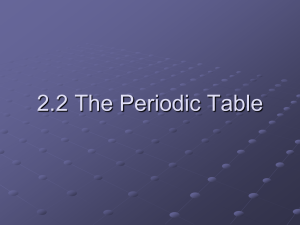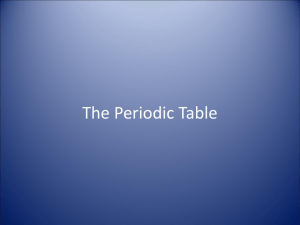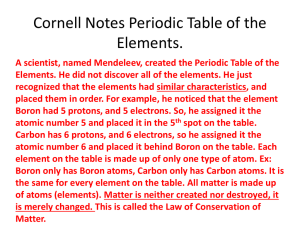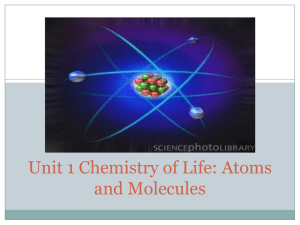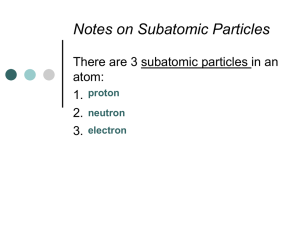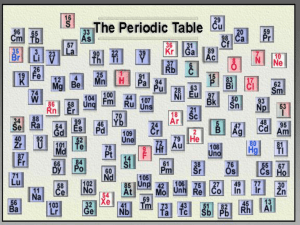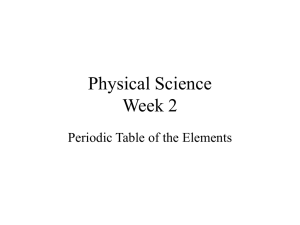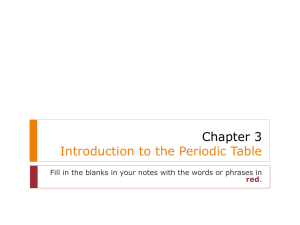The Periodic Table
advertisement
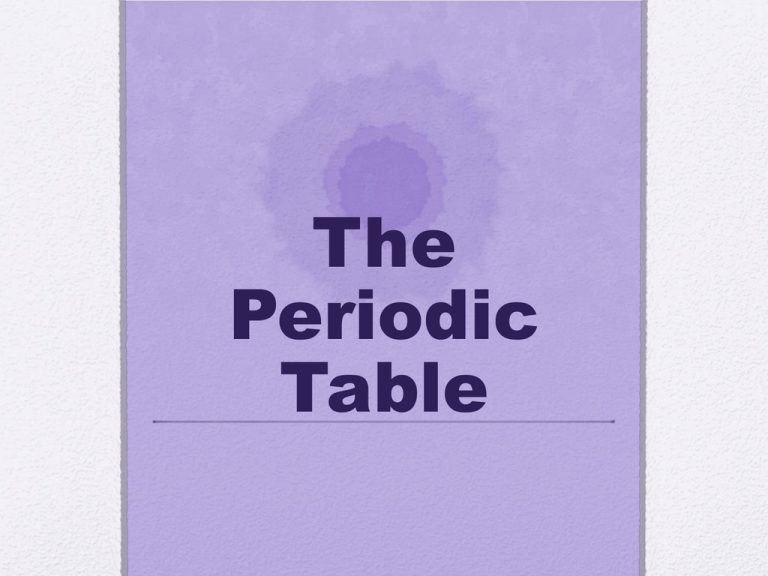
The Periodic Table Why is the Periodic Table important to me? • The periodic table is the most useful tool to a chemist. • You get to use it on every test. • It organizes lots of information about all the known elements. Pre-Periodic Table Chemistry … • …was a mess!!! • No organization of elements. • Imagine going to a grocery store with no organization!! • Difficult to find information. • Chemistry didn’t make sense. Dmitri Mendeleev: Father of the Table HOW HIS WORKED… • Put elements in rows by increasing atomic weight. • Put elements in columns by the way they reacted. SOME PROBLEMS… • He left blank spaces for what he said were undiscovered elements. (Turned out he was right!) • He broke the pattern of increasing atomic weight to keep similar reacting elements together. The Current Periodic Table • Mendeleev wasn’t too far off. • Now the elements are put in rows by increasing ATOMIC NUMBER!! • The horizontal rows are called periods and are labeled from 1 to 7. • The vertical columns are called groups are labeled from 1 to 18. Groups…Here’s Where the Periodic Table Gets Useful!! •Elements in the same group have similar chemical and physical properties!! • (Mendeleev did that on purpose.) Why?? • They have the same number of valence electrons. • They will form the same kinds of ions. Periodic Law • Properties of elements tend to change in a regular pattern when elements are arranged in order of increasing atomic number, or number of protons in their atoms. Families on the Periodic Table • Columns are also grouped into families. • Families may be one column, or several columns put together. • Families have names rather than numbers. (Just like your family has a common last name.) Hydrogen • Hydrogen belongs to a family of its own. • Hydrogen is a diatomic, reactive gas. • Hydrogen was involved in the explosion of the Hindenberg. • Hydrogen is promising as an alternative fuel source for automobiles • REACTIVE colorless, odorless gas at room temperature. Alkali Metals • 1st column on the periodic table (Group 1) not including hydrogen. • Very reactive metals, always combined with something else in nature (like in salt). • Soft enough to cut with a butter knife (low density) • Never found in pure form (always with another element) Alkaline Earth Metals • Second column on the periodic table. (Group 2) • Reactive metals that are always combined with nonmetals in nature. • Several of these elements are important mineral nutrients (such as Mg and Ca Transition Metals • Elements in groups 3-12 • Less reactive than harder metals • Includes metals used in jewelry and construction. • Metals used “as metal.” • Shiny, good conductors of heat and electricity. • Higher densities and melting points than 1 & 2 Why part of the periodic table is down at the bottom. • . The top row is called the Lanthanides, as the element on the left is Lanthanum (La). The bottom row is called the Actinides, as the element on the left is Actinium (Ac). The elements should really be slotted in where that gap is just after the second group. The Lanthanides should go in just after Barium (Ba) and the Actinides should go in just after Radium (Ra). Lanthanides and Actinides • Transition metals. • Just don’t fit in the periodic table without making it so wide that it looks funny. • The lanthanides are shiny and reactive. • The actinides are all radioactive and very unstable. • Elements 95 – 103 do not exist in nature (that we know), but have been manufactured in the lab. Boron Family • Elements in group 13 • Contain one metalloid and 4 metals. (boron(B), aluminium(Al), gallium(Ga), indium(In), thallium(Tl), and ununtrium(Uut).) • Aluminum metal was once rare and expensive, not a “disposable metal.” • It is also the most abundant metal in the earth’s crust. Semiconductors or Metalloids • Look at the stair step going down from Boron. B, Si, Ge, As, Sb, Te, Po, and At are semiconductors. • 1, 1,2,2 • They conduct heat and electricity under certain conditions. Carbon Family Non metals • Elements in group 14 • Contains elements important to life and computers. • Carbon is the basis for an entire branch of chemistry. • Silicon and Germanium are important semiconductors. • Carbon to Oxygen are considered non metals. Nitrogen Family Non metals • Elements in group 15 • Nitrogen makes up over ¾ of the atmosphere. • Nitrogen and phosphorus are both important in living things. • Most of the world’s nitrogen is not available to living things. • The red stuff on the tip of matches is phosphorus. • Varied reactivity Oxygen Family or Chalcogens Non-metals • Elements in group 16 • Oxygen is necessary for respiration. • Many things that stink, contain sulfur (rotten eggs, garlic, skunks,etc.) Halogens (Non metals) • Elements in group 17 • Very reactive, volatile, diatomic, nonmetals • Poor conductor of heat and electricity. • Always found combined with other element in nature . • Used as disinfectants and to strengthen teeth. • Salt forming when bonding with metals The Noble Gases The Noble Gases (Non metals) • Elements in group 18 • VERY unreactive, monatomic gases (inert) • Used in lighted “neon” signs • Used in blimps to fix the Hindenberg problem. • Have a full valence shell. • Colorless, odorless gases at room temperature. Atoms, Isotopes, and Ions • Atoms = equal number of protons, neutrons, and electrons • Isotopes = same number of protons, but different neutrons, therefore different atomic mass • Ions = same number of protons but different number of electrons. How do Structures of Atoms Differ? • The atomic number, Z, tells you how many protons are in an atom. • The atomic number tells you the number of electrons as well. • The atomic number for a given element NEVER changes. How do Structures of Atoms Differ? • Mass number equals the total number of subatomic particles in the nucleus. • The mass number A equals the number of protons plus the number of neutrons. • Isotopes = different number of neutrons. How do Structures of Atoms Differ? • 35/17 Cl or 37/17 Cl • Mass number A – Atomic number Z = number of neutrons. • Because atoms are so small, atomic masses are usually expressed in atomic mass units. Amu • An amu is equal to one-twelfth of the mass of a carbon-12 atom. • The atomic mass on periodic table is a weighted average.
